Angiosperms
2-D says, “We Monarchs like plants, especially milkweed!
We lay our eggs on milkweed because, when our caterpillars hatch, that’s all
they’ll eat. If you want to see us in your yard, grow milkweed. As adult
butterflies, we like to sip nectar from all sorts of brightly-colored
flowers, as long as they’re the sorts of flowers that provide us a place to
land and walk around as we probe down into the flowers with our tongues.”
Monocots and Dicots

Monocots and Dicots
Division/Phylum
Angiospermae
is sometimes called Division Anthophyta (anthe = flower;
phyto = plant) because the common name for this group is the
“flowering plants.” Angiosperms are so named because the seeds are enclosed
within a fruit of some sort.
Division Angiospermae
contains two main classes:
Class Monocotyledones
(the “monocots”) and
Class Dicotyledones
(the “dicots”). These two classes can be distinguished in a number of ways,
including:
| Class |
Seeds |
Leaves |
Flowers |
Roots |
Stem Vascular Tissue |
| Monocots |
one nutrient storage area (cotyledon) |
parallel veins
 |
flower parts in 3
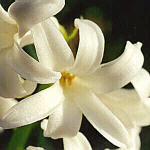 |
many fibrous roots |
bundles scattered throughout the stem |
| Dicots |
two nutrient storage areas (cotyledons) |
net or branching veins
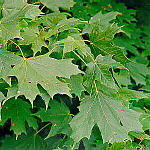 |
flower parts in 2, 4, or 5
 |
one main taproot (may have smaller roots branching off) |
bundles arranged in a ring |
Angiosperm Anatomy:
The parts of an Angiosperm include:
- Roots , which are generally
underground and serve to absorb water and nutrients
- Stems , which come in various
types such as:
- stolon, an above-ground “runner”
- rhizome, an underground “runner”
- bulb, a fleshy stem modified for nutrient storage

- Leaves , which can be either
simple or compound in form and which can either alternate
with each other going up the stem or can be arranged opposite each
other on the stem or as whorled leaves where more than two originate
from the same place on the stem
Leaves can be many shapes from round to heart-shaped to oblong.
Leaves which are entire, all in one piece, are called simple leaves,
while those divided into multiple leaflets are called compound
leaves.
- Compound leaves with their leaflets
arranged like a feather are said to be
pinnately compound (pinna = wing, feather) while leaves with
their leaflets arranged like a person’s fingers are said to be palmately
compound.
Leaves that arise from the branch/stem in pairs are referred to as
opposite leaves, while those which alternate sides up the stem are
referred to as alternate leaves, and if more than two leaves arise
from the same spot, those leaves are said to be whorled.
- Flowers , which are the
reproductive structures of an angiosperm and consist of four whorls of
modified leaves (from outside in):
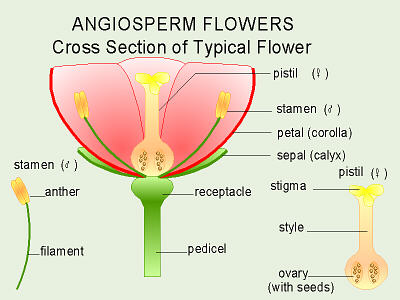
- Sepals (sepi = fence in) (which collectively are
called the calyx), which are often small and green but are
colored like the petals in tulips and lilies, and which generally
enclose the flower before it opens
- Petals (petal = a leaf, spread out, flat) (which
collectively are called the corolla) which are often brightly
colored to attract pollinators (insects, birds, etc.) and may be very
simple to highly modified
- Stamens (stam(en) = anything standing upright, a
thread), the “male” reproductive organs (they make microspores which
turn into male gametophytes), which consist of a stalk (the
filament) and a tip (the anther) where the microspores
are produced and turn into pollen (anthe = flower)
The stamen is the “male” reproductive structure (the microsporophyll), and
the anther is the microsporangium. Microspores are produced and grow into
1n male gametophytes (= pollen) within the anther. Mature gametophytes
are released and transferred to the stigma of the pistil by a pollinator
(wind, insects, birds, etc.), and this process is referred to as
pollination. Each pollen grain grows a pollen tube into the ovary and
its two sperm nuclei travel down the tube to a female gametophyte.
- Pistil (note spelling) or carpel (carpo = a
fruit), which consists of:
- Ovary (ova, ovi = egg)
- the bottom end where seeds are produced
- Style (styl, stylo = a
pillar, stake, column)
- the “stalk” portion
- Stigma (stigma = spot)
- the outer, sticky tip where pollen sticks when it lands
or is placed there
The pistil is the “female” reproductive structure (the megasporophyll),
and the ovary within it is actually the megasporangium. Megaspores are
produced by meiosis, and then form 1n female gametophytes that contain eight
nuclei. Six of these nuclei are in smaller cells at the ends of the
gametophyte, one of which is the actual egg, and two are in a larger cell in
the center.
Botanists group species of plants (or, from the other
direction, the monocots and dicots can be subdivided) based on a number of
characteristics. Botanists pay particular attention to how the flowers are
put together:
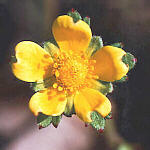 A complete flower has all four layers of parts.
A complete flower has all four layers of parts.
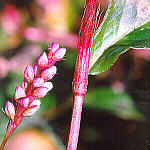 An incomplete flower lacks one or more layers. These knotweed
flowers lack petals (corolla).
An incomplete flower lacks one or more layers. These knotweed
flowers lack petals (corolla).
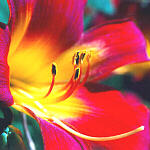 A perfect flower had both “sexes” — both stamens and pistil(s). A
monoecious
plant has perfect flowers or has both male and female flowers on the
same plant (for example, Easter lily, pea, dandelion, and rose).
A perfect flower had both “sexes” — both stamens and pistil(s). A
monoecious
plant has perfect flowers or has both male and female flowers on the
same plant (for example, Easter lily, pea, dandelion, and rose).
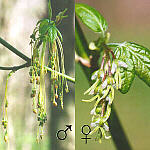 An imperfect flower is lacking either the pistil or stamens. A
dioecious
plant has imperfect flowers on separate male and female plants (for
example, marijuana, hops, persimmon, and boxelder). Note that plants
such as ginkgo, a gymnosperm which doesn’t produce flowers but which
has separate male and female reproductive structures on separate male
and female plants, are also referred to as being dioecious.
An imperfect flower is lacking either the pistil or stamens. A
dioecious
plant has imperfect flowers on separate male and female plants (for
example, marijuana, hops, persimmon, and boxelder). Note that plants
such as ginkgo, a gymnosperm which doesn’t produce flowers but which
has separate male and female reproductive structures on separate male
and female plants, are also referred to as being dioecious.
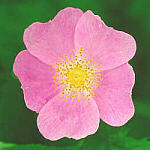 A regular flower is radially symmetrical.
A regular flower is radially symmetrical.
 An irregular flower has bilateral symmetry, and is also known as a
zygomorphic
flower.
An irregular flower has bilateral symmetry, and is also known as a
zygomorphic
flower.
Multiple flowers can be arranged or clustered in various ways,
as shown in this graphic.
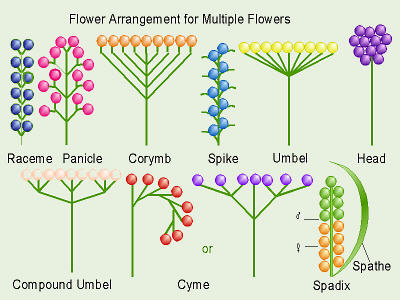

Types of Fruit
- Fruit , which is a ripened (mature) ovary (in which seeds
develop/are found) and which serves as protection and means of dispersal for
the seeds
various types of fruits include:
- Simple fruits arise from one ovary in one flower. Examples
include cucumber, peapod, walnut, tomato, orange, cherry, apple,
dandelion, and maple “helicopter.”
There are a number of types of simple fruit, each with its own
official name.
-
- Aggregate fruits arise from several ovaries in one flower.
Examples include raspberry and strawberry.
- Multiple fruits arise from ovaries in several, tightly-clustered
flowers which grow together into one “fruit.” Examples include pineapple,
mulberry, and breadfruit.
Angiosperm Life Cycle:

Angiosperms have alternation of generations with the 2n
sporophyte being the
dominant generation. The anthers, which are the equivalent of microsporangia,
produce microspores by meiosis, and the microspores develop into male
gametophytes (= pollen).
The ovaries, which are the equivalent of megasporangia,
produce megaspores which grow into female gametophytes, each of which then
produces an egg.
Note that technically the “sex organs” of a plant aren’t
because they produce spores (micro- or mega-) which turn into male or female
gametophytes. The gametophytes bear the true sex organs, such as they are,
and are where eggs or sperm are actually produced.
By some means (wind or an animal pollinator), the
pollen is transferred to the stigma of the pistil, and a pollen tube grows
down into the ovary. Eventually, two sperm nuclei travel down the pollen
tube. Pollination is the transfer of the male gametophyte (pollen)
to the stigma of the female, while fertilization is when the sperm
nucleus and egg nucleus unite.
Angiosperms have an unusual thing called double
fertilization. When the sperm nuclei reach the female gametophyte, one
sperm nucleus and the egg cell unite to form a new 2n zygote (which grows
into an embryo). The other sperm nucleus and two nuclei from the
female gametophyte join to form 3n endosperm which often serves as
food for the embryo.
The embryo sporophyte consists of:
- one or two nutrient-storage areas called cotyledons which are in
contact with (and absorb nutrients from) the 3n endosperm. Seeds of some
species, notably the monocots (think: wheat, corn), store their nutrients
primarily in the endosperm, having very small cotyledon(s) which only absorb
nutrients from the endosperm as needed, while other seeds, including many of
the dicots (think: walnut), store most of their nutrients in their cotyledons
and the endosperm is very small, often reduced to a papery coating (think:
peanut “skin”).

Seed Anatomy
- the epicotyl (epi = upon, over), which is the region
above the cotyledon(s), and which will become the stem and leaves,
- the hypocotyl (hypo = under, beneath), which is the region
under the cotyledon(s). The lower end of the hypocotyl, which becomes
the root system, is called the radicle (radix = root).
Other, Related Information:
Photographs of various angiosperms
Wildflower indentification practice “game”
Further technical information on plant families.
Copyright © 1997 by J. Stein Carter. All rights reserved.
This page has been accessed  times since 16 Mar 2001.
times since 16 Mar 2001.







 A complete flower has all four layers of parts.
A complete flower has all four layers of parts.
 An incomplete flower lacks one or more layers. These knotweed
flowers lack petals (corolla).
An incomplete flower lacks one or more layers. These knotweed
flowers lack petals (corolla).
 A perfect flower had both “sexes” — both stamens and pistil(s). A
A perfect flower had both “sexes” — both stamens and pistil(s). A
 An imperfect flower is lacking either the pistil or stamens. A
An imperfect flower is lacking either the pistil or stamens. A
 A regular flower is radially symmetrical.
A regular flower is radially symmetrical.
 An irregular flower has bilateral symmetry, and is also known as a
An irregular flower has bilateral symmetry, and is also known as a



